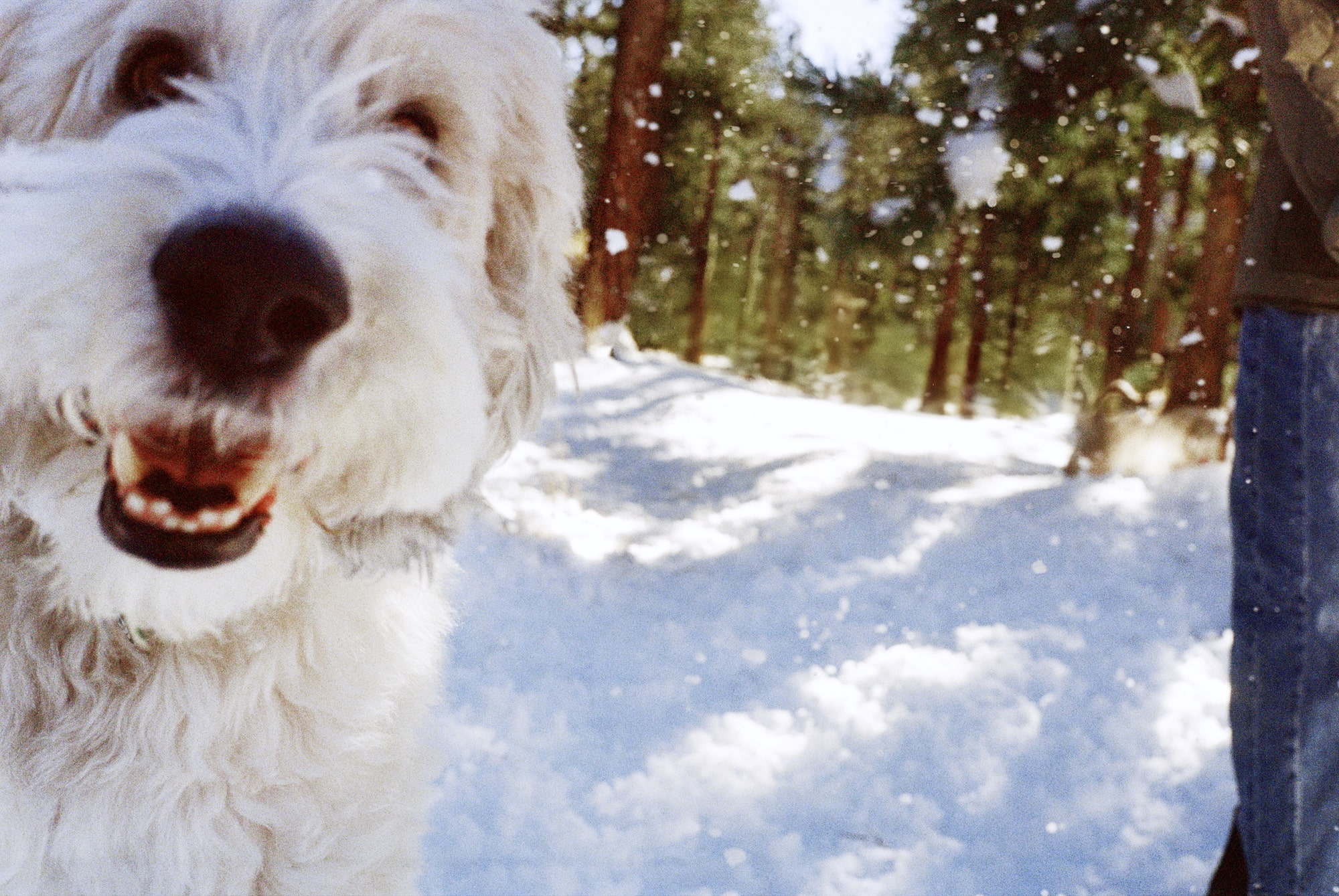In this article:
- OK, my dog loves fetch—but can a dog really have an addiction?
- What happened in this study?
- How many of the dogs in this study were “addicted” to fetch?
- What’s next for fetch-addiction research?
- How can I help my fetch-obsessed dog?
Sometimes the way my dog acts around a soccer ball makes me think she needs to be studied. Her eyes open wide, her bark gets high-pitched, and she will play with said ball—all alone or with a partner—for hours unless I take it from her. And I do eventually take it from her. While I love that she has a hobby, I worry that spending such a prolonged time in this excited state could take a toll.
But Bonnie doesn’t seem to see the value in moderation. Once the ball is hidden, she sniffs it out and emits the most pathetic-sounding cries. More than once, I’ve wondered whether this fixation is harming my dog in some way, or if she’s simply a girl who just wants to have fun.
Now, a team of researchers in Switzerland have evaluated this type of canine toy obsession within the framework of a very human problem: addiction.
OK, my dog loves fetch—but can a dog really have an addiction?
Addiction has a largely agreed-upon definition when applied to humans. According to the International Classification of Diseases (ICD), addiction is the “repeated failure to resist an impulse, drive, or urge to perform an act that is rewarding to the person (at least in the short-term), despite longer-term harm to the individual or others.”
It’s hard to say that a dog’s fetch obsession is truly the equivalent of a human addiction. But the authors of a recent study published in Scientific Reports zeroed in on four criteria that can also be measured through observation in our canine counterparts: craving, salience (meaning that they prioritize toys over other rewards), lack of self-control, and mood modification. Additional criteria—like tolerance, withdrawal symptoms, and consequences—were assessed through owner questionnaires. Two elements of the human criteria for addiction—lying/deceiving and having problems at home or work—were excluded. It’s unclear if dogs can lie, and they don’t have the same types of jobs as people.
The researchers in this study found that approximately one-third of the dogs they tested showed signs of excessive toy fixation that mirrored human behavioral addictions—specifically gambling and video game addiction—rather than substance addictions.

What happened in this study?
The study examined highly play-motivated dogs to determine whether they exhibited the behaviors listed above.
The research team recruited dog owners through social media, specifically seeking animals with high or excessive motivation for toy play. After excluding dogs outside the target age range and those unable to complete testing, researchers conducted behavioral tests on 105 dogs ranging from 12 months to 10 years old.
During testing, researchers observed how dogs responded when their favorite toy became inaccessible. Some animals demonstrated intense focus on the unavailable toy, persistent attempts to access it, and reduced interest in alternative rewards such as food or social interaction with their owners. The research team recorded these behaviors on video and measured how long dogs spent trying to reach blocked toys.
The adverse effects that the researchers looked for included dogs showing a disregard for their own physical health and safety through overexertion or risking injuries to ligaments and joints, plus other behavioral issues like irritability, a high level of frustration, or inability to accept that the toy had been put away (demonstrated by pacing, jumping, or staring at the box or shelf where the toy had been placed). The authors considered these signs of possible addiction in dogs because a disregard for potential harm is a feature of addiction in humans.
How many of the dogs in this study were “addicted” to fetch?
Based on the behavioral scoring, the researchers classified 33 out of the 105 dogs as having a high tendency toward “addictive-like” behavior. This included spending much more time trying to get an inaccessible toy than those dogs deemed “low-tendency,” or staring at where the toy was hidden for a lot longer than the others. The equivocation in the phrase “addictive-like” is intentional. The authors wrote that it’s “important to be cautious when pathologizing behavior, especially given that even in humans, addictive behaviors are still difficult to define and measure.”
“Dogs that appear obsessed with toys cannot be easily distracted from their fixation on the preferred object—demonstrating the high salience of the toy,” reads the study. “Such dogs may even lose interest in other stimuli or social interactions as long as they have access to the toy, or sometimes even when it has been removed from reach.”
Working dogs have been selectively bred for their detection and retrieval skills, which often rely on an intense play drive (that’s why toys serve as primary rewards during training for these types of dogs). And working dog breeds were overrepresented in the researchers’ sample, which they noted is probably due to their own selection of highly toy-motivated dogs—meaning that this study can’t be extrapolated to reflect a general population of dogs. Although a little over 30 percent of the dogs in this study displayed high-tendency behaviors, it doesn’t follow that 30 percent of all dogs have this issue.

What’s next for fetch-addiction research?
The authors wrote that further study is needed to find out where healthy (if extremely focused) play ends and maladaptive play begins. “Do high-AB [addictive-like behavior] dogs still ‘like’ to play,” they asked, “or have they progressed to primarily ‘wanting’ and the compulsive need to continue?”
Beyond that, the authors called for future research into whether similar patterns appear in other wild canid populations in order to determine whether toy fixation stems from domestication. They also would like to see studies on addictive-like behavior and other conditions such as autism or attention deficit hyperactivity disorder, which share features like impulsivity and hyperfocus.
How can I help my fetch-obsessed dog?
There are good reasons to help an obsessive dog find fetch-life balance.
As Maddie Messina, a Certified Applied Animal Behaviorist and Founder of Paws for Thought Dog Training, told us, “repetitive fetch” can cause health issues like the wearing down of teeth or joints. And that’s not all.
“It can also pose a resource-guarding challenge amongst some,” Messina said, “and […] it can be really dangerous for a guardian to have a dog who, in an off-leash space, will stop responding to known recall cues if they are focused on another dog’s ball.”
If you’re concerned that your dog may display a high tendency toward addictive play behaviors, take heart that there are tried-and-true methods for helping dogs for whom ball is life. Even prior to this study, many trainers have been aware of the problems extreme fetch or similar preoccupations can present to dogs, and have techniques to promote a healthier approach.
As with so much dog training, the keys here include knowing your own dog and observing them closely. Sari Carel, a certified dog trainer and founder of Brooklyn Pup Dog Training, said, “Behavior will show up on a spectrum, and paying attention to your individual dog’s body language will help you determine if the game is playful, beneficial and fun—or has gone overboard into fixation and obsessive behavior.”
If you’ve observed your dog’s body language and the consequences of intense fetch, and you’ve determined that it’s not the best thing for them, then you can tap a certified trainer to help manage the behavior. Messina encourages owners to play different games with their dogs, ones that can involve the ball or not. “For example,” she said, “rather than repeated fetch, sprinkle in some ‘find it’ reps where you ask your dog to hold a position, then hide the ball for them to find.”
Owners can also leave the ball at home while taking the toy fiend on a long walk or hike. “If you’re looking for ways to burn off extra energy,” Messina added, “try teaching your dog tricks or even basic obedience skills with treats. No matter what, you must have a clear ‘all done’ cue that you teach your dog over time to signal to them when the ball is no longer available. Otherwise, many dogs will fixate on it.”
Along with more enrichment, less playing time with the toy, and more basic training, Carel suggests working with dogs on relaxation exercises. These can include “teaching your dog ‘place’ and reinforcing calm behavior whenever the dog volunteers it, such as [by] lying down on one hip rather than a stiffer down position.”
“It takes time, but it is truly worth it to help dogs cultivate the ability to relax,” she said.
Learning to relax can be beneficial for all dogs (and humans, for what it’s worth). But not all dogs who love fetch are fetch addicts.
The authors compare fetch-loving dogs to gamers. Billions of people around the world play video games, and only a small number of them are considered addicts.
“Similarly,” the authors wrote, “many dogs may greatly enjoy toy play without developing harmful compulsions.”




